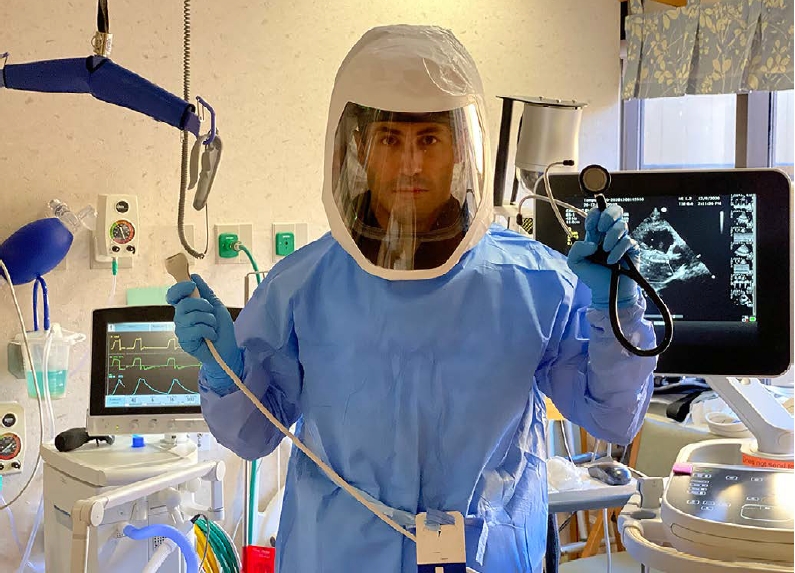The stethoscope is a routine, crucial, and obligatory part of the patient-physician interaction, denoting completeness and marking diagnostic competence. Stethoscope-based lung auscultation has a reported sensitivity of 37% for common respiratory pathologies [1], while lung ultrasound has sensitivity and specificity above 85% and 93%, respectively, when compared with chest X-ray and/or chest computed tomography (CT)-based diagnoses of pneumonia [2].
The coronavirus disease 2019 (COVID-19) pandemic has transformed the practice of modern critical care, mandating the routine use of personal protective equipment, including powered air-purifying respirators and personal protective hoods. These changes have presented unique challenges in the use of the stethoscope, particularly for the rapid diagnosis of acute complications in prone ventilated patients. Nonetheless, these struggles have highlighted the unique applicability and benefits of cardiopulmonary point-of-care ultrasound (POCUS) (Fig. 1) to diagnose and monitor cardiopulmonary manifestations of severe acute respiratory syndrome coronavirus 2, to facilitate timely initiation and optimization of therapeutic interventions [3], to limit daily chest radiography and repeat chest CT scans, to guide optimization of positive end-expiratory pressure, ventilatory weaning, and improved clinical diagnoses of pneumothorax, pleural effusions, pulmonary consolidations and edema, and to aid in resource allocation, including risk stratification for those with an elevated risk of mortality [4].
Yet, nearly 70 years after the introduction of medical ultrasound, only a handful of doctors worldwide are capable of the independent proficient use of ultrasonography in cardiorespiratory diagnostics.
The inadequate volume of clinicians proficient in cardiopulmonary ultrasonography greatly limits the available training programs. The insufficient availability of affordable, robust high-end POCUS scanners further hinders the widespread adaptation of POCUS in modern medical practice.
While stethoscope training is well integrated into medical training, cardiovascular ultrasound training frequently remains sporadic and unstructured. It starts late, after medical school, despite the established feasibility of early learning, often not being offered even during specialty fellowship. Highly variable national and local specialty-based guidelines and recommendations have been published, detailing requirements for echocardiographic training to achieve the desired levels of competency in critical care [5]. Pulmonary and pleural ultrasound training remains largely unstructured.
To move forward, we must acknowledge that the deeply rooted tradition of exclusively stethoscope-based respiratory point-of-care assessment of critically ill patients is inadequate and that supplementation with heart and lung ultrasonography is invaluable, particularly during the current COVID-19 pandemic. Indeed, these skills should be considered integral to the modern practice of medicine. The immediate availability of greater resources is needed for strategic widespread basic cardiopulmonary ultrasound education, including a standardized medical school curriculum.
The formidable impact of bats on humans has paradoxically imposed on us the dreadful consequences of coronaviruses along with the beautiful lessons of echolocation. The COVID-19 pandemic has brought devastation, but can also catalyze innovative developments and an overdue paradigm change towards the mass implementation of portable, point-of-care cardiopulmonary ultrasonography.



 Print
Print facebook
facebook twitter
twitter Linkedin
Linkedin google+
google+

 Download Citation
Download Citation PDF Links
PDF Links PubReader
PubReader ePub Link
ePub Link Full text via DOI
Full text via DOI Full text via PMC
Full text via PMC




